Week 5 Film Review: How the Raiders ran over the Bears
By Tyler Arthur
I am an Oakland Raiders fan who watches every snap of every game they play. I see every week as the patterns emerge, similar things happening – both good and bad… This allows me to predict what I think is going to happen on a weekly basis more accurately than casual fans.
This week though, I didn’t expect the result that happened – well, not quite.
I was certain that the Raiders would play their best football early on, expecting them to do the majority of whatever scoring they could in the first half, as they have started strong and looked great with the more pre-determined elements of the gameplan. That was exactly right.
I also expected them to tail off in the third quarter and find it much harder to score later on, which again was spot on.
What I didn’t expect was for them to get a second wind and end up victorious against the best defense in the entire NFL after a thrilling game which, frankly, looked like it was going to find a way to somehow end in a Bears W.
This week we’re going to look at some of the key plays which lead the Oakland offense to do the impossible; nullify one of the best players in the world, and defeat the best defense in the league.
The Raiders defied all expectations and absolutely dominated in the run game, and I’m going to take a look at the key run plays of this Week 5 matchup.
The first play that we’re going to look at is a really awesome example of how the Raiders’ offense was able to be innovative and aggressive in the run game, doing some unconventional things (or unconventional alternatives to standard things) to achieve success. The star of the show on Sunday was rookie running back Josh Jacobs, who is an early candidate for Offensive Rookie of the Year, and it started in the first quarter.
The first play that got the London crowd excited was also a great example of some unique play design from Head Coach Jon Gruden and OC Greg Olson. They came out in a tight set formation in 12 personnel, with their two tight ends (who both did a fantastic job all game) Foster Moreau and Darren Waller in three-point stances to the right, and a tight stack of two receivers to the left.
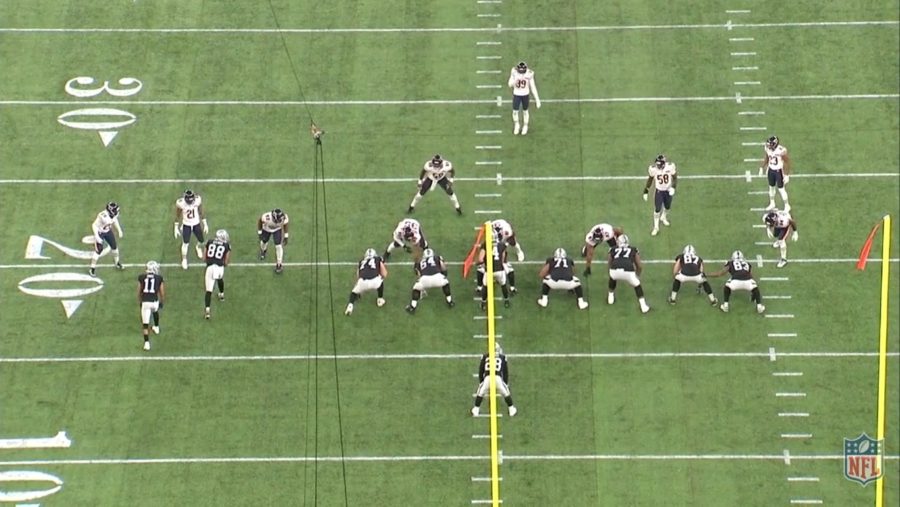
As you can see, Khalil Mack is lined up to the backside between the wide receivers and the left tackle Kolton Miller – watching where number 52 is will be an important theme for this article as it was a key part of the ‘home’ team’s gameplan. The Raiders knew exactly where Mack would be lined up if they came out in this formation, and they were going to run counting on it, so they could run straight back at him.
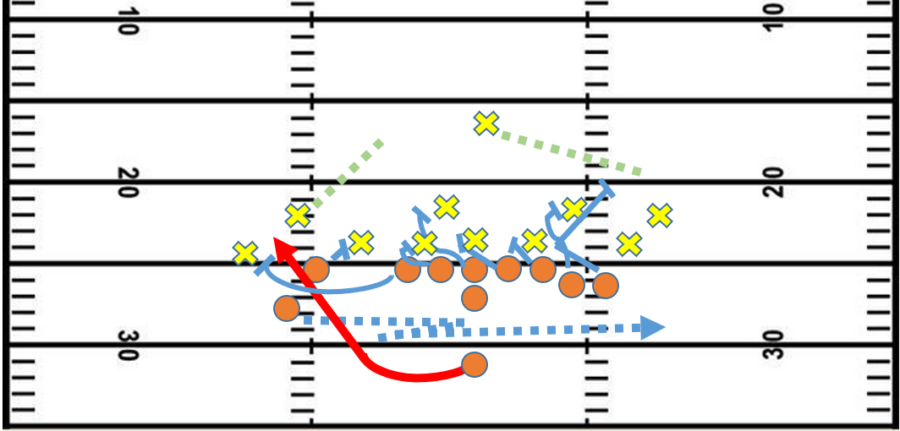
The play design above looks complicated, but it’s really just a Toss Crack play, with the added motion to try and create the look that they want. The blue dotted arrow shows Trevor Davis running a back and forth motion, before running a jet action to the TE side of the formation. When Davis goes in motion, the two Bears safeties rotate (as signified by the green dotted lines), and give Oakland the perfect look for this play.
The crack block is – by necessity more than design, I might add – the job of Marcell Ateman, a wide receiver who is buried down in the depth chart, but who has the biggest assignment on the entire play. He uses the natural leverage from his starting position to get in between Mack and the running lane, and washes him in towards the middle of the field, while Kolton Miller runs straight past him and takes on a cornerback. The thing which is so effective about this design is that essentially the Raiders choose to use leverage to turn what would be a very difficult run into two favourable matchups – if they just ran a usual toss play, Miller would have to try and get a reach block on Mack who is in a wide 9 technique in a two-point stance, but this was much more effective. Ateman’s advantage is his alignment, Miller has a matchup between a left tackle and a cornerback.
After the two leftmost blockers get their job done, everyone else is tasked with pretty standard zone blocking to the left, although it is made fairly difficult by the 52 [their formation, not Mack] look the Bears are lined up in.
Rodney Hudson does a fantastic job, getting from his position as centre all the way over to cut the flowing middle linebacker, and everyone else does what is asked of them, leaving Josh Jacobs with a clean running lane and the chance to work his magic.
Once you give this rookie some room to run, he makes plays, simple as that, just like he did here to make people miss, breaking arm tackles and spinning out of attempted hits. The ability for Jacobs to identify his lane and make a play is rarely demonstrated as well as on this next play – the first of the second quarter.
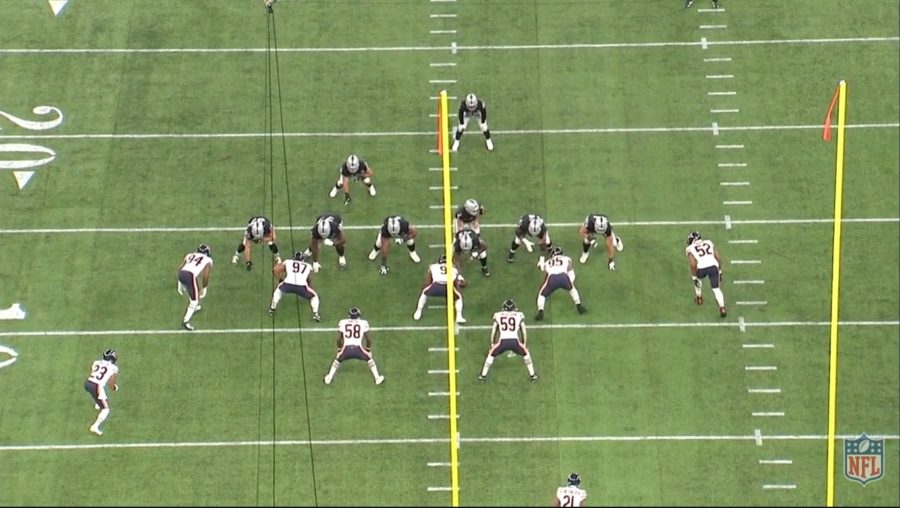
The Raiders are in the red zone here, with the first play of the second, on 1st and 10, and break in 22 personnel. They come out in a strong formation with both the tight end and fullback Alec Ingold (one of the MVP’s of this win) on the defensive left of the formation [as you see it in the above screenshot]. The two wide receivers are both on the side opposite to the strength.
What’s the first thing you notice in the above image if not for the position of Khalil Mack? Once again (what a coincidence…) he is lined up on the backside of the formation, away from the tight end and fullback. The reason he is here is because they want him to have either an easier pass rush, or the ability to chase down a run from behind as the other defensive linemen absorb blocks and slow the play down.
Wrong.
The reason that Khalil Mack is on the backside of the formation is because this is where Gruden and Olson want him to be. Oh, and spoiler alert, just because it’s the backside of the formation doesn’t mean it’s the backside of the play – as we just saw on that first design we looked at. The Raiders specifically game planned to have a lot of runs that went to the exact opposite direction the formation initially suggested – why? Because they decided that the best way to beat Khalil Mack was to go straight at him.
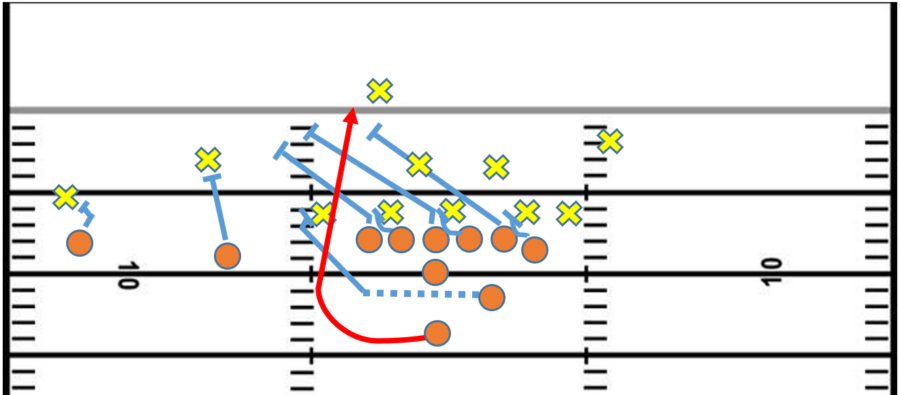
The Raiders coaches had clearly worked out that Mack would be on the backside whenever they had a strong/heavy formation, and on this play, they motion the fullback across from that strong side, and then snap the ball to give him a running start on a cut block to take the ex-Raider rusher out of the play.
Once Mack had been taken down, there was still plenty of work to do, though, on this toss play.
This zone blocking scheme works by pairing each blocker up. The left tackle punches then leaves to the second level, leaving the left guard to pick up; the centre punches then leaves to the second level, leaving the right guard to pick up; the right tackle is uncovered so he doesn’t have to punch, but when he leaves, the tight end picks up behind him.
This blocking scheme allows Kolton Miller, Rodney Hudson and Trent Brown to cause absolute chaos, and gives Josh Jacobs a beautiful cutback lane. When you look at the play design above it shows how the blocking is very much zonal, however the Bears flowed very quickly to the play side, meaning that it was easy for the Raiders to wall them off when they attempted to come back and make a play.
Here’s how things looked at the moment Jacobs made his cutback.
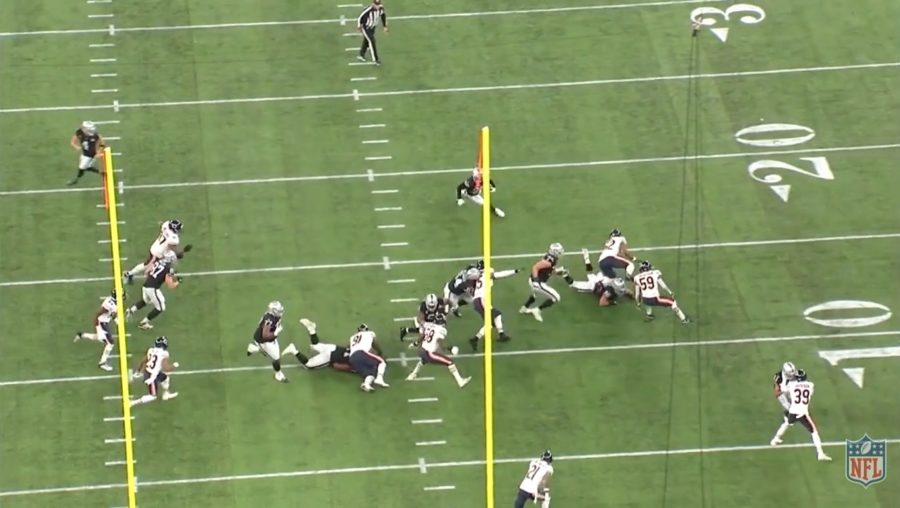
All of the traffic was moving to the defense’s right, and the Raiders offensive line just followed behind, then caught them as they attempted to turn back. Jacobs did a fantastic job – all game, in fact – at identifying when to change direction to maximise his blockers, and his one-cut ability is absolutely incredible for a young player, combining quickness and agility with great vision. He doesn’t always need to ‘set up his blocks’ which is the phrase used when the back slows down until things line up, instead he stretches the defense by moving laterally, then identifies the point at which he can turn upfield and find a crease, as he did on this play, leading to the Raiders’ first touchdown.
After the Raiders scored, the Bears visibly felt the pressure and on the play that would have marked their three-and-out, quarterback Chase Daniel threw an ugly interception. This gave the Raiders the ball back with brilliant field position and a chance to put up 14-points in less than five minutes.
They quickly got down to the three-yard-line and were on 3rd and goal, when they dialled up yet another play that incorporated two key elements of their gameplan: 1. Use motion and unpredictable blocking angles and setups. 2. Targeting and going straight for Khalil Mack.
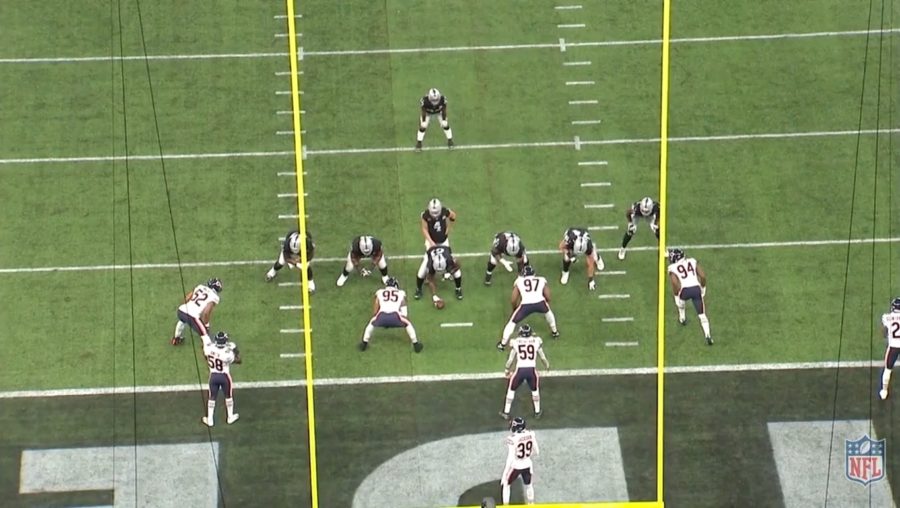
As you can see, the Bears haven’t changed that much from what the Raiders expected, they now only have four down-linemen but still have Khalil Mack on the backside away from the strength of the formation. Mack is still in a wide technique, ready to chase down a run play or rush the passer. The Raiders only have six blockers as opposed to the seven that they had on the previous two designs we looked at (which spreads the defense thinner, and takes three defenders over to defend the twin receivers to the left), but they still utilise their knowledge of where the Bears would be set up against this formation and they exploited it.
This play is a nice demonstration that Josh Jacobs doesn’t have to be a superhero (although he is) for the Raiders to put the ball in the endzone, with their third-choice RB DeAndre Washington getting in here on a simple but effective call.
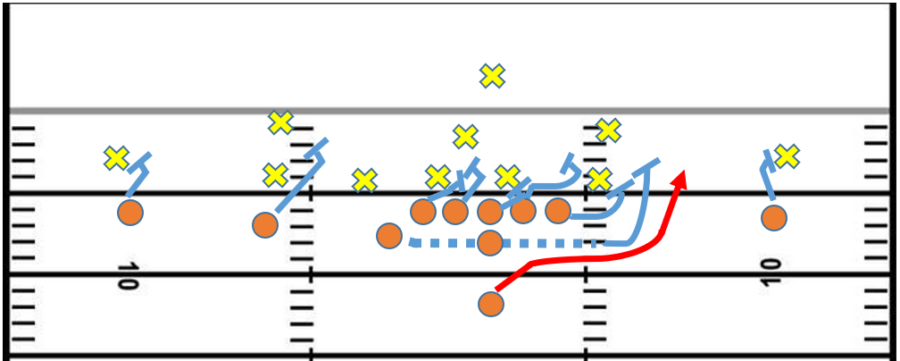
The play is just a pretty normal stretch / outside zone design, but with the motion of the tight end across to the play side it created a really favourable alignment to block all of the flow back in and give the RB the lane to bounce it outside.
Once Darren Waller – who, by the way, really impressed me with his blocking – has motioned across, Khalil Mack assumes that the TE is coming for him, and takes an aggressive step inside to avoid it, but this actually makes Trent Brown’s job at right tackle significantly easier. What should have been a make-or-break reach block (which I imagine Waller would have been prepared to help with before getting to the second level), Mack’s effort to avoid a block actually ran him straight into the bigger one, and he got washed inside out of the way and away from the play.
Similarly, to the previous design, the four other offensive linemen that are coming across from the backside of the play just double through and work in pairs – standard zone blocking work. The two key blocks on the outside stop the flow, and the pile up makes the interior and backside guys’ jobs significantly easier. Washington can then make his way around the edge untouched before turning north to fight into the end zone.
The use of motion and knowing where Mack is going to be once again delivered, and the Raiders were up 14-0.
After that DeAndre Washington score, the Raiders finished the half with a field goal, before predictably returning more to the mean, allowing the Bears to get back into the game.
The Raiders had a very costly fumble on their first time on the ball in the third, and then Chicago scored three consecutive times, making it 21-17.
As if to make it worse, while the Oakland offense attempted to fight back and win the game, they got pinned back on their three-yard line with time running down, oh, and the scariest defense in the NFL in the shadow of their own goalposts.
This was the part of the game that I definitely didn’t predict.
Time to set the tempo, and to start what could be their final chance at a winning drive.
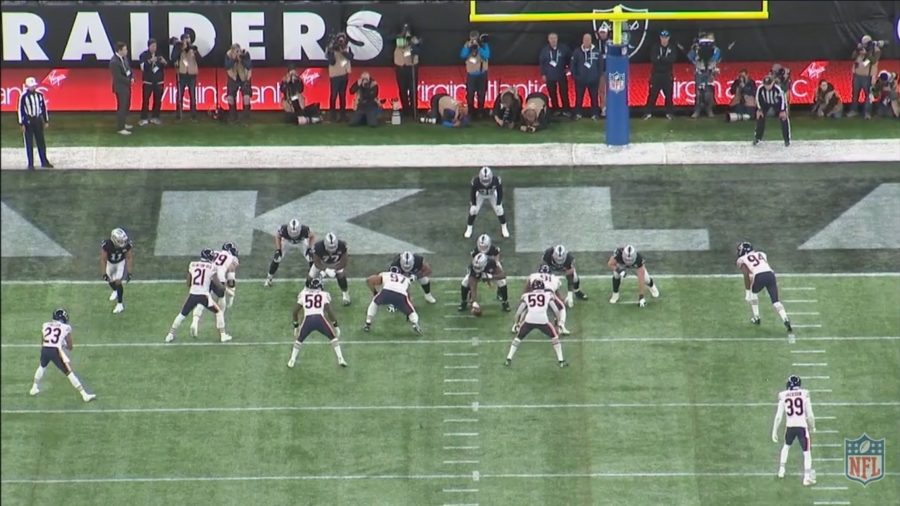
What do you notice?
Yeah, you’re correct – Khalil Mack isn’t on the field.
This play is the tone setter for the most important drive of the game, and the Bears star isn’t there. The Raiders don’t really care, to be fair, as they were running the ball straight at him anyway, but right now they’ve got a bigger thing to worry about, getting out of their own endzone.
The Bears are in a nickel package, but with the strong safety playing the box, to try and get a good balance of both run-stopping and damage-limitation on any pass attempts that Gruden and Olson have in store. The Raiders come out in a slightly unconventional version of what feels like 20 personnel, although the would-be fullback is actually an offset tight end who is in the backfield but outside the width of the tackle.
The three wide receivers are in a fairly standard two by one, with the single receiver tight in the slot to the boundary side, and the two receivers spread to the wide side.
The Bears defensive front-seven (well, six and the safety) is working an over front to the side with the TE and has the linebackers and strong safety towards that side of the formation to make sure the Raiders can’t overpower them to the offensive right, with the backside 7-technique that is usually Mack still present, now a role played by Leonard Floyd who Jon Gruden tactfully noted ‘isn’t a bag of rocks’ in the build up to the game.
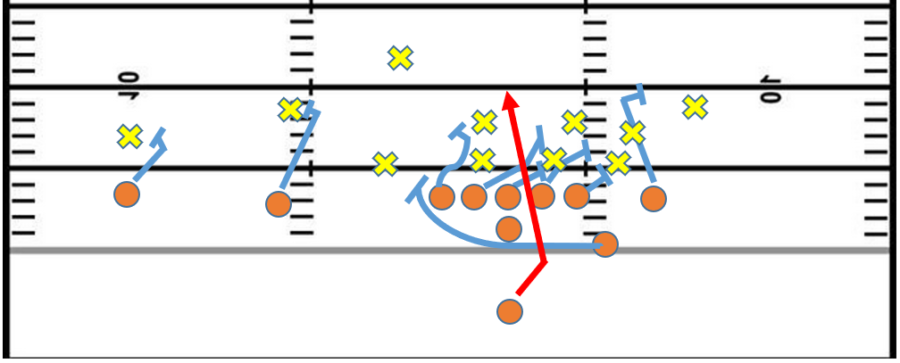
This is a pretty simple trap concept, which uses the wham block from the offset tight end to release Kolton Miller to the second level and create a nice lane for a one-cut run after the running back influences to the right. Josh Jacobs starts off running towards the defensive left, which is also where everyone from the left guard across is blocking. After the linebackers start to flow, he cuts back and has a beautiful lane right up the middle.
The wham block is designed to take on the defensive end, but on this particular play, the defensive tackle lined up in a 2i technique to the offense’s left bounces outside and ends up getting drawn into a double-block by Foster Moreau, who takes out both the tackle and end at once.
This play set the tone perfectly for the drive which you may have worked out by now is the drive which went 97-yards to brush aside the most dominant defensive unit in the country.
Watch this play and tell me this run doesn’t look as effortless as they come. This is a rookie at running back with an offensive line that’s missing a starter, by the way.
Josh Jacobs does brilliantly on that play – yes, the lane from the blocking was really nice, but what will get in the head of the Bears most is how once he outlasts that blocking he always seems to make things difficult. He maintained his balance beautifully after stumbling through into the second level, and ended up with a hard-fought 15-yard gain to start them off.
The drive that gave the Raiders the lead really had a mixture of literally everything. They ran the ball hard, they successfully ran a fake punt, Carr made a big time throw, two big passing plays to Foster Moreau (the unsung hero of this game, without a doubt – especially on this drive). All of those plays came as they methodically made their way down the field, and finally ended with the Raiders on the two-yard line.
After starting on their own three, now – 95 yards later – the Raiders are on the Bears two, on 1st and goal, on the south side of the 2-minute warning.
Watching this game, I knew that this was the set of downs that would define the Raiders’ first six weeks. Five games, boiled down to just four downs.
It only took one.
The Oakland Raiders run game flat out defeated the Chicago Bears. Not only that, it was punctuated by a play which served as the perfect microcosm for the game – they did something simple, but they did it their way.
I don’t think that a play art diagram will help much here, it is the most unique and yet hilariously simple strategy I’ve seen for gaining the final two yards all season.
Coming out in a two-back jumbo set, Derek Carr handed the ball off to the rookie superstar running back and sent him towards the stacked goal line. What preceded Josh Jacobs leaping athletically over the pile was none other than Alec Ingold, an undrafted rookie fullback who we most recently saw with his forehead flying past Khalil Mack’s lower legs. Like a sword with a bayonet at the front, the Raiders sent two running backs hurtling over the top of the wall of cut blocks– Ingold cleared the way with a flying block, and then Jacobs dived behind him into the end zone to take a late lead for the home side away from home, which was the final lead change of the game.
Even on the final play, the one which goes down in the box score as a short TD to Jacobs, it was a team effort, with his blocker going literally above and beyond to earn the Raiders their third win of the season.
The Raiders did it.
There were some bad calls from referees, there was a bad fumble that shifted momentum, and there was an elite defense, featuring an elite ex-player all trying to put the three on the wrong side of the record, but none of that could stop a truly dominant showing on the ground.
They passed the ball when they needed to, Carr throwing a very under the radar 229 yards, including some important plays when it mattered the most. They used smart protection schemes and nullified one of the best defenses in the last decade with both the run and pass, and they kept one of the best players in the league quiet in his rush attempts. All while absolutely pounding the rock and putting in the most impressive running performance of Josh Jacobs’ career so far.
The Oakland players came to London early and didn’t plan on leaving without a W, and now they have a week off to celebrate, while Gruden and Olson plan on how to take on Green Bay in Week 7.
If they run the ball like they did this past week for the rest of the season, Josh Jacobs will be the offensive rookie of the year, the Raiders will make the playoffs and Khalil Mack will get a very cheeky Christmas card from Derek Carr and friends.
Oh, and don’t forget – Gabe Jackson should be healthy again in a couple of weeks, just in time for the second half of the schedule that isn’t as brutal…?
It’s time to start taking the Raiders seriously, because their offense is more than serious, even without multiple key players – that doesn’t worry them though, they only have one thing on their mind after their bye week.
Just win, baby.

Tyler Arthur
NFL Film and Prospect Analyst
A graduated Journalism student, Tyler also writes for Read American Football and Gridiron Hub. He played Wide Receiver and eventually Quarterback for his university team at DMU, and is now using his knowledge and passion for learning to dive deeper into the analysis of X’s and O’s in the NFL.
